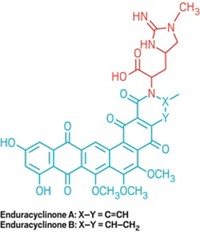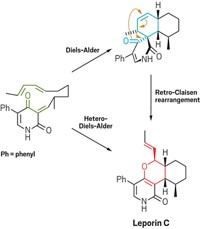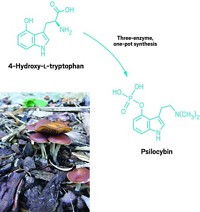Advertisement
Grab your lab coat. Let's get started
Welcome!
Welcome!
Create an account below to get 6 C&EN articles per month, receive newsletters and more - all free.
It seems this is your first time logging in online. Please enter the following information to continue.
As an ACS member you automatically get access to this site. All we need is few more details to create your reading experience.
Not you? Sign in with a different account.
Not you? Sign in with a different account.
ERROR 1
ERROR 1
ERROR 2
ERROR 2
ERROR 2
ERROR 2
ERROR 2
Password and Confirm password must match.
If you have an ACS member number, please enter it here so we can link this account to your membership. (optional)
ERROR 2
ACS values your privacy. By submitting your information, you are gaining access to C&EN and subscribing to our weekly newsletter. We use the information you provide to make your reading experience better, and we will never sell your data to third party members.
Synthesis
A Lomaiviticin Is Scarce No More
Natural Products: Semisynthesis of rare, highly cytotoxic agent reveals stereochemistry
by Stu Borman
September 24, 2012
| A version of this story appeared in
Volume 90, Issue 39

The natural product lomaiviticin A is one of the most cytotoxic compounds known and a potential anticancer agent. But it has been available only in vanishingly small quantities, its stereochemistry was incompletely assigned, and its mechanism of action was not known.
Synthetic chemist Seth B. Herzon of Yale University and coworkers have now eliminated the supply problem, established the natural product’s stereochemistry, and gleaned a few clues about how it kills cells (J. Am. Chem. Soc., DOI: 10.1021/ja3074984).
Lomaiviticins A and B were first isolated from a bacterium 11 years ago. They have complex and unusual structures, including two diazofluorene (dinitrogen-bearing polycyclic) and several carbohydrate groups.
Both lomaiviticin A and B exhibit antibiotic activity, and A is an exceptionally potent anticancer agent. The compounds’ unusual structures suggest that this cytotoxic power might arise from a novel mechanism of action. But bacteria make little of the compound, and without a way to synthesize it, scientists have made scant progress in evaluating lomaiviticin A’s mechanism or therapeutic potential.
To develop their route to lomaiviticin A, Herzon and coworkers cultured a strain of the producing microorganism and isolated three new lomaiviticins: C, D, and E. As it turns out, the bacterium produces lomaiviticin C in much more useful quantities than A—up to 120 times as much. The researchers developed conditions to convert C to A in one step by adding a missing diazo group to C. This conversion generated enough A to enable them to establish its complete stereochemistry.
They have now also begun studying how lomaiviticin A kills cells. They note that A’s two diazofluorenes may account for its potency, which is two orders of magnitude greater than C’s. They have also synthesized some lomaiviticin analogs and are evaluating their clinical potential.
Gary A. Sulikowski of Vanderbilt University, a specialist on the biological properties of natural products, comments that “the DNA-cleaving properties, superior cytotoxicity, and symmetric structure of lomaiviticin A suggest that interesting modes of double-stranded DNA cleavage, reminiscent of antibiotics such as calicheamicin, may be operative.” The Yale team’s method for converting C to A will facilitate studies of this mechanism, he says.
Natural product expert Eric W. Schmidt of the University of Utah adds that the new work is exciting because it combines a solution to the lomaiviticin supply problem with a complete three-dimensional structure and a preliminary mechanistic concept. The work, he says, could help lead to a detailed understanding of how the lomaiviticins work, a way to synthesize them, and evaluations of their potential as drugs.





Join the conversation
Contact the reporter
Submit a Letter to the Editor for publication
Engage with us on Twitter